Back to the 80s? What soaring inflation, US rate hikes and a stronger dollar mean for EM sovereign debt
Soaring inflation, rate hikes and a stronger dollar are reminiscent of the early 1980s – a decade that brought a wave of EM sovereign debt crises. This year has already seen Sri Lanka default, hit by an external liquidity crisis. In this article, we look at how other developing nations will fare and highlight a tricky environment for EM frontier sovereigns
EM sovereigns face a tough backdrop, but larger nations should remain resilient
With most countries only just starting to recover from the Covid-driven shock, the war in Ukraine has provided a further significant external shock for emerging market (EM) hard currency sovereign bonds this year. An environment of heightened geopolitical risk, monetary tightening in developed markets, surging inflation and commodity price volatility has made for something of a toxic combination for EM nations. This environment has prompted plenty of warnings from policymakers and the official sector about a further swathe of EM sovereign defaults and risks of a more systemic EM debt crisis.
A clear parallel has been drawn to the 1980s when a swathe of defaults and crises hit developing nations on the back of the Federal Reserve's aggressive rate hikes to tame persistent US inflation. The chart below left shows the scale of EM sovereign defaults (mainly on foreign currency bank loans) in the 1980s, which reached almost a third of the outstanding stock of EM external public debt. In particular, Latin American sovereigns felt the pressure, given the unsustainable build-up of external debt relative to exports seen in the region (shown in light blue, below right).
EM sovereign defaults have been limited in recent years compared to the 1980s
1: EM sovereign foreign currency bank loans & bonds in default (% of EM public external debt); 2: EM external debt stocks by region (% of goods & service exports)

This year, rising US Treasury yields have started to increase borrowing costs for EM issuers, locked many out of international bond markets, as well as drawing investor portfolio flows away from EM countries and strengthening the US dollar. IIF data has shown almost $40bn in cumulative portfolio outflows from emerging markets since February this year, pressuring weaker nations’ balance of payments.
Sri Lanka defaulted after this external shock pushed the nation over the edge, although vulnerabilities had been building long before. Ill-advised tax cuts in late 2019 meant an early end to its IMF programme and loss of international bond market access. Consequently, sparse FX reserves had to be used to repay regular maturing Eurobonds and finance the current account deficit, while fiscal deficits have increasingly been financed by the central bank. Surging food and fuel prices finally meant maintaining a stable exchange rate and continuing to service hard currency bonds was nearly impossible as FX reserve levels collapsed to nearly zero. Russia, Belarus, and Ukraine have also all entered default, albeit for vastly different reasons on the back of war and sanctions.
Our view is that more defaults are possible among ‘frontier’ nations – loosely defined as lower-rated, smaller (and therefore less systemically important to the global economy) countries. JP Morgan’s Next Generation Markets (NEXGEM) Index defines these frontier nations as having high yield ratings (BB+ or lower) at both S&P and Moody’s, a weighting of less than 2% in the broader EMBI Global Diversified index for 12 months and not being actively engaged in seeking EU membership.
However, we are unlikely to see the widespread contagion of previous EM crises given improved fundamentals and more decisive policy action from major EM central banks. Generally, external debt levels now are far lower relative to exports and GDP than during the 1980s, while larger developing countries have built up buffers of FX reserves and floated their exchange rates in response to the chastening experiences of previous crises.
Distressed sovereigns: What is the market telling us?
Unsurprisingly given the tough macro backdrop, 2022 has been a poor year for EM hard currency sovereign bonds. The ICE USD EM sovereign index has generated total return losses this year of around 19%, slightly weaker than similar indices for EM corporates (minus 14%) and broadly in line with EM equities. Returns for EM hard currency bonds have been hit by both rising US Treasury (UST) yields and wider credit spreads (reflecting larger country risk premia and increased investor risk aversion towards emerging markets).
Despite a slight rebound since mid-July (when year-to-date returns were as low as minus 22%), returns at this stage in the year are the weakest since 1998, during the Russian financial crisis. Local currency EM bond indices have held up better, in part due to the resilience of Latin American currencies, as have US High Yield (HY) corporates given the more stable macro situation there (minus 10% and minus 11%, respectively YTD).
Fixed income total return indices (Jan 2022 = 100) - ICE indices
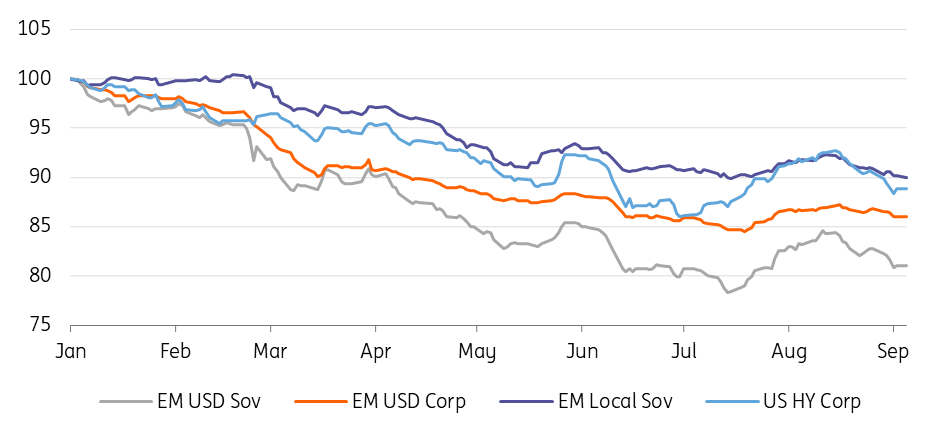
And with concerns that Sri Lanka’s default could be the canary in the coal mine for other more vulnerable EM sovereigns, markets have begun to price the risks of further crises among some of the weaker credits. The number of sovereigns trading at distressed levels (with dollar bonds spreads on average over 1000bp over USTs) has increased to 17, from 8 at the beginning of the year. This is down from 21 in mid-July, but remains an elevated number, and a few significant sovereigns such as Egypt, Angola and Nigeria have fluctuated around that level. Other than just signalling investor concerns, these spread levels also effectively lock issuers out of the international bond markets, which can be self-fulfilling in a crisis as sovereigns no longer have access to a key source of financing to roll over bond maturities.
Other than six nations already in default (Lebanon, Belarus, Zambia, Suriname, Sri Lanka, Ukraine), the below chart highlights further countries in distress, from the ICE EM USD sovereign sub-indices. Ethiopia has also already signalled intentions to restructure its debt under the G20 Common Framework. Argentina and Ecuador have recently restructured their debts and therefore have low near-term bond maturities, without fully regaining market confidence. Ghana and Pakistan stand out as sizable issuers ($13bn and $7.5bn in dollar bonds outstanding, respectively) that have experienced significant volatility and look reliant on the IMF and other bilateral lenders to meet their near-term funding needs. Tunisia has faced domestic political instability. El Salvador’s unorthodox policymaking has caused concerns among bondholders and the IMF, but the nation plans to buy back some of its upcoming 2023 and 2025 bonds, which Finance Minister Alejandro Zelaya has claimed shows its “capacity to pay.”
EM USD bond spreads (OAS vs Govt) by HY country (bp)
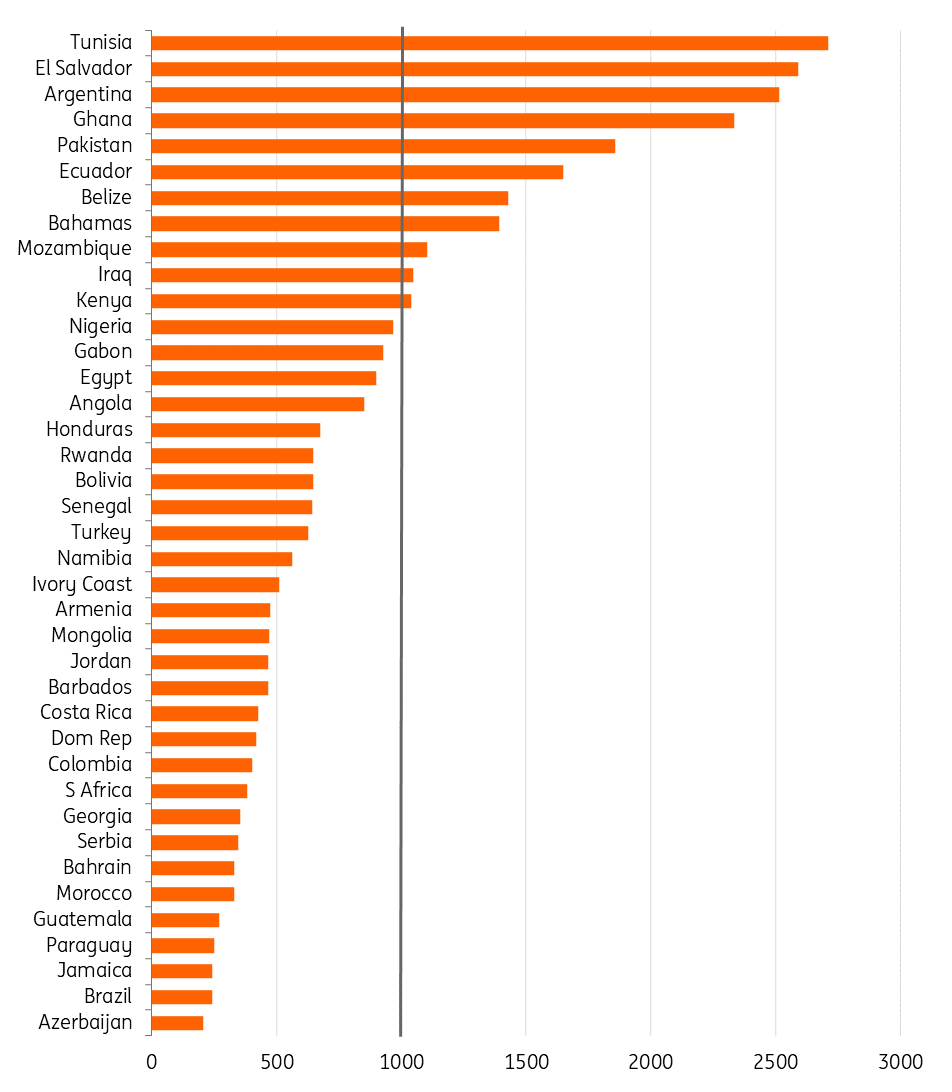
Sovereign fundamentals: Where do the vulnerabilities lie?
As previously mentioned, Sri Lanka succumbed to the combination of a large debt load and debt servicing costs, along with rapidly depleting reserves against large external financing needs. In an environment of tighter global financial conditions, a key indicator of vulnerability is a country's external financing requirement (current account deficit and external debt amortizations). The chart below scales these versus FX reserves, which can be used to finance external deficits absent financial inflows. It also plots the YTD change in FX reserves to see which countries have already been experiencing pressure in this regard. Sri Lanka, as expected, is the most extreme outlier on this scale, with the bottom right quadrant the area of most vulnerability. Pakistan, Ghana, Egypt and Kenya stand out as large issuers, all at or near distressed spread levels. The surge in commodity prices this year has put pressure on the current account balances of large food and fuel importers. In contrast, on this measure, Angola looks much safer despite current spread levels in line with many regional peers, with its current account balance supported by high oil prices.
YTD change in FX reserves vs gross external financing needs (2022-23 ave) as % of reserves
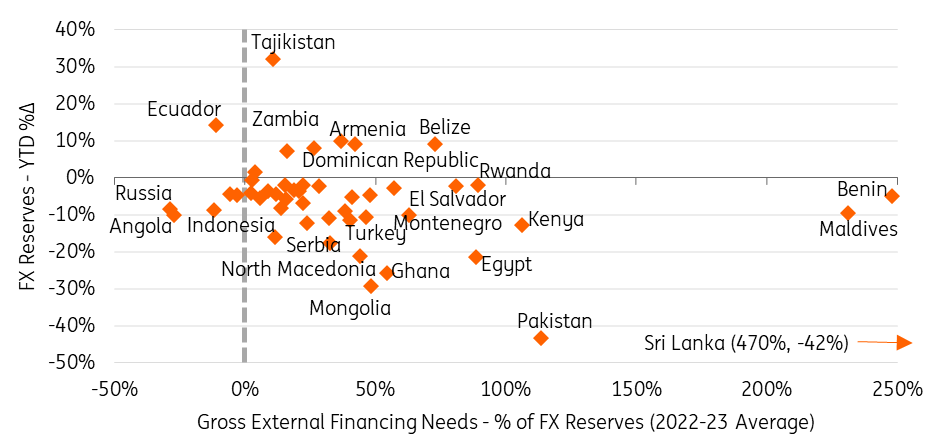
On the fiscal side, high government debt levels also represent a vulnerability, in particular when analysing if creditors will need to take haircuts in a default or restructuring scenario. Here we plot government debt to GDP versus interest costs as a percentage of revenues to see where debt servicing is becoming prohibitively expensive. Sri Lanka is again the outlier, while Ghana, Egypt and Pakistan also show further vulnerability. Bahrain has high debt levels but lower servicing costs, in part due to support from peers in the Gulf Cooperation Council (GCC). In contrast, Nigeria’s government debt is fairly low, but revenue collection is weak and therefore debt servicing costs screen as higher.
Government debt (% of GDP) vs interest expenditure (% of revenues)
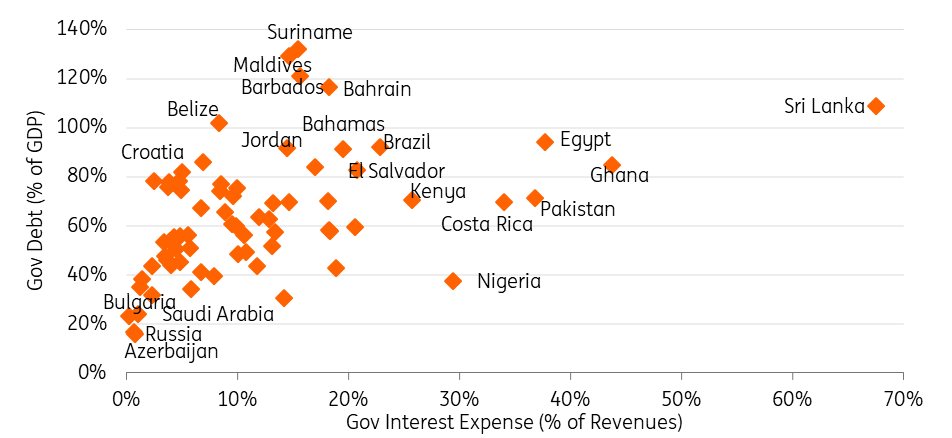
Generally, government debt levels rose significantly during the Covid crisis and now the current backdrop of high food and fuel prices means spending cuts on subsidies will be difficult to enact politically. With protests rising globally amid surging inflation and a cost of living squeeze, poorer nations remain particularly vulnerable to fuel and food prices.
Median CPI inflation by region (YoY%)

Despite fairly pro-active central bank policy for most, inflation pressures have shown little sign of easing, in particular in CEEMEA and Latin America. Economic pressures can easily evolve into political unrest and become far less predictable, making unpopular reforms far more difficult.
To build on this analysis, the key for near-term default risk is looking at upcoming Eurobond maturities, and how they can be refinanced or repaid. The chart below shows refinancing needs on maturing bonds by HY country and year until the end of 2024, scaled by FX reserves. A positive for weaker Sub-Saharan African credits like Angola and Nigeria is that near-term refinancing risks are low. Ghana, Pakistan and Egypt are still below a reasonable risk threshold of 20%. Kenya has one sizable maturity, but not until 2024. Bahrain is the outlier, as has been the case in recent years, but strong support from peers such as Saudi Arabia mitigates some of this risk. Turkey’s refinancing needs are sizable, so the nation will hope to regain market access in the near term. Risks for the likes of Oman and Azerbaijan are offset by strong current account surpluses and additional foreign assets held in sovereign wealth funds. On the whole, Eurobond refinancing needs are not at critical levels for most HY sovereigns in the coming year or two, but a longer period without market access would still be concerning for many.
Eurobond refinancing needs by year for HY sovereigns (% of FX reserves)
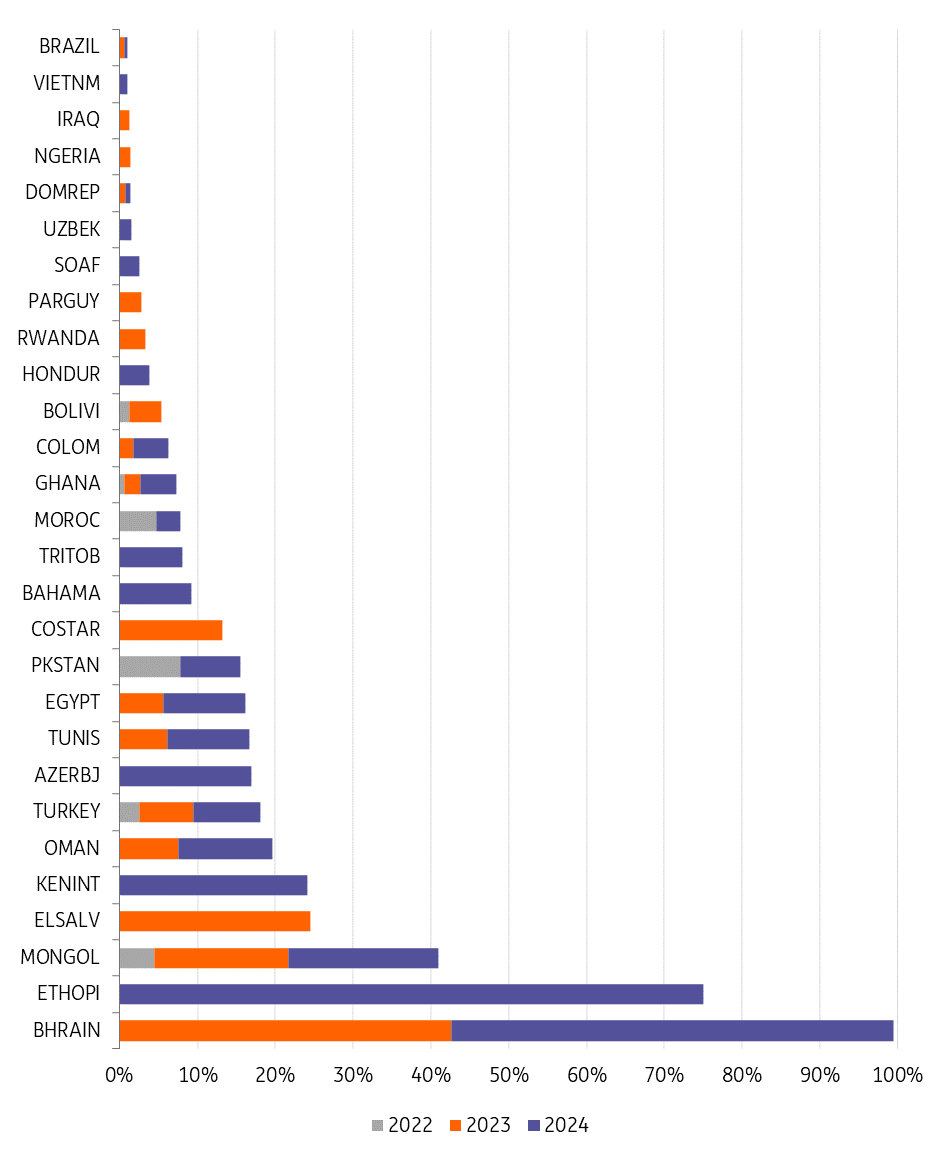
Contagion risks: What are the implications for EM as a whole?
To offset some of the negative news and risks highlighted, it is worth returning to our view that we are not staring down the barrel of a looming global EM crisis, with signs of widespread contagion. For one, many ‘major’ emerging markets have improved fundamentals relative to historical periods of stress. The likes of Mexico, Brazil, Indonesia, the Philippines, and South Africa have built up FX reserves, increasingly issue in local currency, and many are benefiting from improved terms of trade given elevated commodity prices. Central banks have been fairly active and orthodox in attempting to move ahead of the curve, and the Fed, albeit with a few notable exceptions. Foreign holdings of EM local assets are also relatively low and investor positioning in EM is fairly light, reducing another aspect of vulnerability.
Additionally, the IMF remains a key backstop for many weaker ‘frontier’ nations. Many of the stressed sovereigns mentioned are negotiating or already in IMF programmes (Kenya, Pakistan, Egypt, Ghana) and positive news or financing disbursements can often start a virtuous circle of investor confidence and market access. That’s not to say, however, that the IMF acts as a safety guarantee for all. The interplay of reform requirements with domestic politics can be tricky – Sri Lanka left it too late to engage, having previously ended its IMF programme early and enacted tax cuts against recommendations, while the likes of Turkey have pre-emptively ruled out any IMF cooperation. And a country can still end up in a crisis and default when in an IMF programme (Argentina is the most recent example). Given these dynamics, alternative sources of official financing, such as China, India and the oil-rich Gulf nations have become increasingly important, along with the geopolitical factors that influence such decisions.
When putting these risks into context, valuations for EM sovereign credit look attractive at the headline level (ie index spreads wide versus normal levels), but delving deeper it’s clear that HY sovereigns are the key driver of this. IG spreads, even in the BBB tier, look relatively tight to historical levels, while single-B sovereign spread levels remain elevated.
EM USD sovereign OAS vs govt by rating tiers - ICE Indices
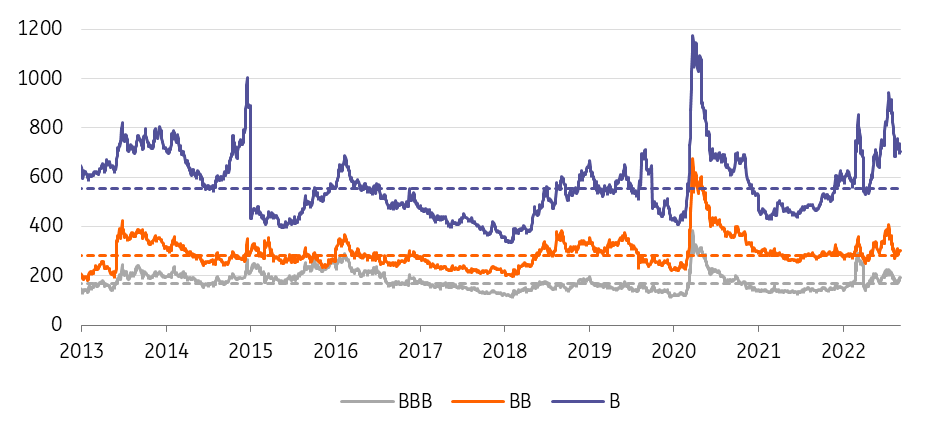
There has been plenty of regional differentiation in this dynamic. Surging energy prices have seen some significant outperformance and fundamental improvement for major oil exporters, such as the GCC in the Middle East, and Azerbaijan. GCC nations now have a combined weighting of around 20-25% in the major EM hard currency sovereign indices, having seen significant growth in issuance from almost nothing a decade ago, driven in part by the 2014 commodity price crash.
In contrast, a key area of concern has been the outlook for Europe, given the ongoing energy crisis pointing to a more severe growth slowdown. In turn, this has fed into weaker performance for Central and Eastern European sovereigns such as Hungary, Romania and Serbia. Before this year, the CEE region was perceived as fairly stable within the hard currency space, with many sovereigns trading at tight spreads relative to their ratings and fairly low volatility.
Looking forward, we expect volatility to continue as we remain in the middle of a tricky period for EM sovereigns. Uncertainty remains over the potential scale and duration of global monetary tightening along with the extent of the likely upcoming economic slowdown. Spread levels on HY EM dollar bonds have narrowed since mid-July, recovering somewhat from their sharp summer selloff but remaining elevated versus the past decade average. While we don’t expect spreads to re-test the highs seen in mid-July, we do expect a larger-than-normal risk premium to remain priced in as investor concerns continue over the potential for further sovereign defaults. The key differentiator for lower-rated sovereigns is likely to be IMF support. Nations with a strong track record of IMF cooperation and the political breathing room to enact less popular reforms should be better placed to ride out the storm. Recent evidence of an uptick in IMF activity (agreements and dispersals for the likes of Zambia, Sri Lanka, Pakistan and Chile) is likely to be a trend that continues.
This publication has been prepared by ING solely for information purposes irrespective of a particular user's means, financial situation or investment objectives. The information does not constitute investment recommendation, and nor is it investment, legal or tax advice or an offer or solicitation to purchase or sell any financial instrument. Read more
Download
Download article